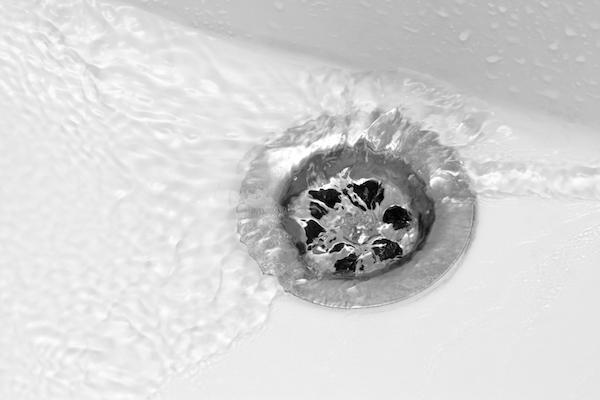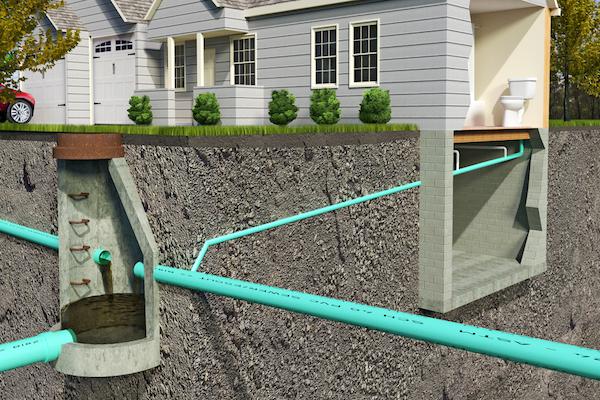Where Does Our Water Go?
April 7, 2017
Last month, we started chronicling the journey of Dallas’ water from the beginning. We saw the reservoirs where all Dallas’ water originates, the facilities that make it safe to drink, and even the faucets in your house. Now, we’ve reached the end of the journey. Where does your water end up after you flush it down the drain? How does it get there?
Starting right where we left off–in your sink!–here’s the last leg of the journey, step-by-step.

Where Do Drains Lead?
“Wastewater” is any water that’s been used. You flush wastewater down a drain, either in a sink, a tub or shower, or toilet. Drains work by using simple gravity. When you push down the sink plunger, the drain sucks water through the opening into the appliance drain line.
As the water falls straight down the vertical appliance line, it gathers speed and velocity. That speed allows it to move past the p-trap and into your home’s drainpipes.
P-Trap
A P-trap is the “P”-shaped curve beneath a drain and near the end of the drainline. The P-trap keeps wastewater, sewage backflow, and sewer gases from flowing back up through your pipes and into your home. It works because when water comes down from the drain, it’s moving fast enough to push up past the P-trap’s sudden curve. once it gets over the P-trap’s hump, gravity keeps it sliding down the pipe and into the drainpipes.
Backflow and gases, on the other hand, can’t generate enough speed coming back up from the pipes to make it past the P-trap’s curve. Consequently, the P-trap “traps” the water, keeping it from rising high enough to stink up your home.
Drainpipes
After water gets past the P-trap and heads down the remainder of the appliance line, it joins up with a wider, longer series of pipes. These pipes are your home’s drainpipes. Each of your drain’s appliance lines empties out into this series of pipes. Drainpipes come in various widths to better accommodate the type of wastewater they’re transporting; toilet drainpipes are the widest. The size and verticality of your home’s drainpipes help to make sure wastewater continues falling at the rate and direction it should be.
Vent
Your home’s drainpipes connect with your plumbing system’s air vent at this point. Your plumbing’s air vent is a long, hollow, narrow tube that runs straight up and down. One end connects with your home’s drainpipe, and the other end runs all the way out to the rooftop. The vent supplies fresh air into the drainpipes, which is necessary to prevent air suction entering the pipes from slowing or stopping flow. As long as your vent is uncovered and your drainpipes are clear, wastewater will safely travel down your pipes and out to your sewer line.

How Does Water Leave My House?
To recap: we flush the water down the drain. Each drain contains its own appliance pipe and P-trap. Gravity accelerates falling water, making it fast enough to get over the P-trap and into the drainpipes. Once inside the drainpipe, water continues to flow freely downward through your pipes with the help of the vent system.
But where do the drainpipes lead? How does the water actually leave your system? Here’s how:
Lateral Connection
All drainpipes eventually connect to one, final exit pipe. This wide pipe is called the house lateral, lateral line, or lateral connection. It is the largest drainpipe in your home’s plumbing system, with a diameter between 1.5 and 2 inches wide. The lateral connection is also the lowest pipe in your plumbing system; it’s buried beneath the building and yard.
Like the other pipes in your home, the lateral connection relies on gravity to move wastewater that enters it. The lateral connection slopes, allowing water to continue to naturally travel downward through it. As the lateral connection slopes further downward, it also leads out of your home, through your yard, and off your property. There, your lateral connection links up with the municipal sewer line. The part of the lateral connection that’s located on your property is called the “upper lateral,” and the part that isn’t is called the “lower lateral.”
Sewer Main Line
Via the lateral connection, all the wastewater in your home flows out into the municipal city sewer line. The Dallas city sewer runs for 4,020 miles beneath the entire city and transports the wastewater of all Dallas residents every day.
Sewers, like the lateral connection, are built at slight angles to allow water to continue to flow with gravity. These angles only need to be very gradual, since the speed of water discharging from multiple lateral connections pushes wastewater along down the sewer line towards its final destination.

Where Does Sewer Water Go?
Wastewater Treatment Facilities
City wastewater travels through the Dallas sewer line until it reaches one of Dallas’ two wastewater treatment facilities: Central or Southside. Like the drinking water treatment plants, the City of Dallas Department of Water Utilities funds and operates these facilities. Wastewater treatment facilities use a rigorous, scientific purification process to clean wastewater as it comes into the facility. The USGS Water Science School provides a step-by-step walkthrough of this process here.
Dallas wastewater facilities screen out solid mass, aerate water to remove gases and reintroduce oxygen, remove sludge and scum, and kill waterborne bacteria using chemicals. Between the two of them, the Central and Southside facilities can treat up to 260 million gallons of water a day. In 2015 and 2016, the city of Dallas treated 76 billion gallons of water.
Recycling
Once facilities treat wastewater until it meets the high federal standard of cleanliness, they recycle it back into the water supply. Dallas’ wastewater facilities safely discharge all treated wastewater into the Trinity River. The wastewater of Dallas actually plays an instrumental role in keeping the Trinity River flowing.
Oftentimes, another facility in a different city re-processes treated wastewater, adding it to the drinking water for another city! Almost all of Houston’s drinking water comes from the Trinity River, so it wouldn’t be inaccurate to say we supply Houston with the water they drink! You’re welcome, Houston!
Call it nerdy, but learning about the journey our city’s water takes every day makes us proud to be plumbers. By making sure your pipes are running the way they should be, we’re kind of like supporting characters in the epic odyssey of Dallas water. By using your home’s water, you are too.
If you’re worried something in your home is impeding your water’s righteous journey (to Houston), give us a call today. We’ll make sure your drinking water, and your wastewater, get where they need to go (Houston). It’s our honor!